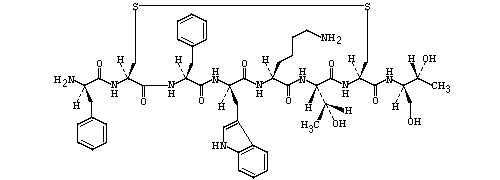Disulphides formation of octreotide
Abstract:To study the octreotide synthesis by solid-phase peptide synthesis,a novelmethod ispresented.In this method. the CTC resin.a conventional Fmoc.protocol and iodine-mediated oxidation were applied to make the disulphides formation of the octreotide. The final product was purificated by HPLC,and the purity reached 70.26% .The result indicates that the technology of solid-phase peptide synthesis is feasible for large-scale preparation of octreotide because of simplified procedures,high yield and purity.
Keywords:octreotide, somatostatin, solid-phase peptide synthesis, disulphides
What is Somatostatin?
Somatostatin, a regulatory inhibitory peptide, was originally isolated from sheep hypothalamic tissue by chance in 1973 by Burgus and Brazean et al., and its chemical structure was determined. It is a natural tetraceutectic peptide with a pair of intramolecular disulfide bonds.Somatostatin has a wide range of endocrine inhibition effect and has a wide range of clinical application prospects, but the half-life of somatostatin in animals is very short, only 2min to 4min, so it is not suitable for research and treatment. Therefore, synthetic has become one of the ways to obtain somatostatin.
Research of Octreotide
Coy and Sarantakis et al. simultaneously synthesized somatostatin tetraceutein in 1973 by solid-state method. Meinhofer's laboratory synthesized somatostatin using modified N-fluorene methoxycarbonyl (Fmoc) amino acids by a one-by-one extension method.In 1982 Bauer et al. synthesized a somatostatin analogue named Octreotide. Octreotide has a short peptide chain, and 6 amino acids in SS are removed compared with somatostatin. The eighth position is amino-L-monoalcohol, which is not easy to be rapidly hydrolyzed by protease and is easy to be synthesized artificially. Its half-life in vivo is as long as 2h, and its inhibitory effect on hormone secretion is stronger than somatostatin.

For example, octreotide has about 70 times stronger inhibition on Gh release than SS, 23 times stronger inhibition on glucagon, and about 3 times stronger inhibition on insulin. So octreotide is a long-acting somatostatin analogue, also known as somatostatin releasing statin (SRIF or ss), Octreotide is widely used in the treatment of acromegaly, endocrine tumors of the digestive tract, non-secretory tumors of the digestive tract, upper gastrointestinal bleeding, acute pancreatitis, systemic sclerosis, irritable bowel syndrome, cancer cachexia, topple syndrome, psoriasis, postural hypotension, hypotension during surgery and other diseases.
Read Related Articles:
Copyright © 2020 Omizzur Inc | Terms & Conditions | Privacy Notice | Sitemap